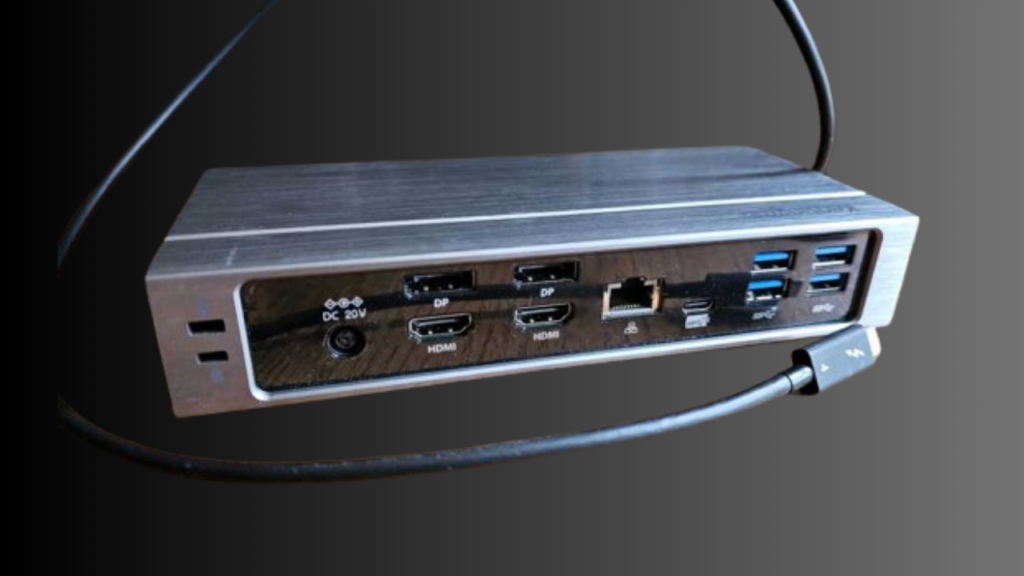In the battle between gaming PCs and gaming laptops, one area where PCs have a clear advantage is in the number of available ports. These ports are essential for connecting various peripherals and devices, a feature even the best gaming laptops often lack. This is crucial not only for gaming and streaming but also for boosting productivity if your gaming laptop doubles as a workstation. Enter the docking station—a small device that significantly expands your laptop’s connectivity. Here’s why a docking station can transform your laptop experience:
1. Expanded Connectivity
Modern laptops have become thinner and lighter, often sacrificing connectivity for portability. It’s common to see laptops with just a couple of USB-C ports. Docking stations address this by offering a range of additional ports, including USB-A and USB-C for data transfers and charging. Advanced models even support the latest connections like USB4 and Thunderbolt 3 and 4.
They also come with video outputs like HDMI and DisplayPort, Ethernet connectivity, SD card readers, and audio jacks. This variety of ports is invaluable for gaming, streaming, and working, allowing you to connect microphones, webcams, and other accessories with ease. Choose a docking station that has the connections you need without overwhelming yourself with unnecessary options.
2. Multiple Monitor Support
Laptops often fall short in supporting multiple monitors, usually offering just one video output that might not even match your external monitor’s type. A docking station resolves this by providing multiple video outputs, enabling you to connect one or more monitors through HDMI, DisplayPort, and other ports. This can dramatically enhance productivity by giving you a larger and more flexible workspace, perfect for both work and play.
3. Faster, More Secure Networking
Slim laptop designs often omit Ethernet ports, which are crucial for fast and secure network connections. Many docking stations include a Gigabit Ethernet port, or even faster options, allowing your laptop to enjoy stable and high-speed internet. This is particularly beneficial for gaming, where lower latency and improved connection stability are crucial. Ethernet also provides enhanced security compared to Wi-Fi, reducing vulnerability to congestion and cyber-attacks.
4. Simplified BYOD for Remote Work
For remote workers who occasionally visit the office, the BYOD (Bring Your Own Device) system can be cumbersome. Logging into different networks and reconnecting peripherals each time can be a hassle. A docking station simplifies this process. Leave it at the office connected to all necessary devices, and just plug in your laptop when you arrive. This seamless integration can also be useful when working between different offices or departments.
5. Faster Charging for Multiple Devices
Charging multiple devices like phones, cameras, or earbuds through your laptop can drain its battery and limit available ports. A docking station eliminates this problem by providing additional charge-capable ports, all powered through mains electricity. This means you can keep your laptop and other devices charged without compromising on connectivity.
6. KVM Switches
If you work with multiple laptops or desktops, a docking station with a built-in KVM (Keyboard, Video, Mouse) switch can be a game-changer. A KVM switch allows you to use a single set of peripherals with multiple systems, simply by pressing a button. This is perfect for switching between a personal and work laptop or a laptop and a desktop, enhancing your workstation’s comfort and productivity.
7. Improved Ergonomics and Cable Management
Routing numerous accessories through a docking station can significantly reduce cable clutter, making your workspace more ergonomic and visually appealing. By keeping devices permanently plugged into the docking station, you avoid the constant hassle of plugging and unplugging, keeping cables neatly tucked away and your desk organized.
8. Enhanced Security and Stability
Some docking stations come with physical locks to secure laptops, preventing unauthorized removal. This is useful in shared or open environments, ensuring that laptops stay in place unless unlocked with a key. Additionally, securing the docking station itself and routing cables through inaccessible areas can further enhance security and stability, ensuring consistent connectivity for peripherals and networked devices.




















